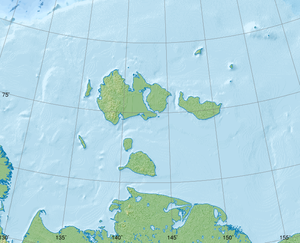Semyonovsky Island
| Semyonovsky Island | ||
|---|---|---|
| Waters | Laptev Lake | |
| Archipelago | Lyakhov Islands ( New Siberian Islands ) | |
| Geographical location | 74 ° 15 ′ N , 133 ° 55 ′ E | |
|
|
||
| length | 14.8 km (1823) | |
| width | 926 m (1823) | |
| Map of the New Siberian Islands from the mid-1820s with the Semyonovsky and Vasilyevsky Islands. | ||
The Semjonowski Island (also Semjonow Island , Russian остров Семёновский ) was one of the Lyakhov Islands of the New Siberian Islands in the Laptev Sea . Since it was mapped by Pyotr Anjou in 1823, it has rapidly eroded and disappeared around 1950. Today, the Semyonovskoye Shoal (Семёновское мелководье) is located at its position .
The Yakut Maxim Lyachow discovered Semjonowski Island together with Vasilyevsky Island to the south of it in 1815 when he lost his direction on a sleigh ride from the Lena Delta to Kotelny . Eight years later, the Russian explorer Pyotr Anjou visited the island on a sleigh trip to Belkovsky Island . At the time, it was 14.8 kilometers long and nearly a kilometer wide. Adolf Erik Nordenskiöld saw the island on August 28, 1878 when he was the first to cross the Northeast Passage on board the Vega . From September 10 to 12, 1881, George Washington DeLong rested with the other shipwrecked Jeannette on Semenovsky Island.
By 1912, when participants in the Hydrographic Expedition of the Northern Arctic Sea landed on it, the length of Semyonovsky Island had been reduced to 4.6 km. In 1936, when Vasilyevsky Island no longer existed, it was only two kilometers long, 500 m wide and 23.6 m high, in 1943 1.2 km long and 350 m wide, in 1947 only 350 m long and 40 m m wide. In 1950 Semenovsky Island disappeared.
The reason for the disappearance of the Semyonovsky and Vasiliewski Islands is likely to be thermoabrasion , a form of permafrost erosion caused by thawing ice blocks inside sediments .
Individual evidence
- ^ Leopold von Schrenck : On the prehistory of the expedition equipped by the Imperial Academy of Sciences to the New Siberian Islands and the Jana Land . In: L. von Schrenck, CJ Maximowicz (ed.): Contributions to the knowledge of the Russian Empire and the neighboring countries of Asia , third volume, Volume III, St. Petersburg 1887, pp. 1–61, here p. 34 .
- ↑ Schrenck: On the prehistory of the expedition equipped by the Imperial Academy of Sciences to the New Siberian Islands and the Jana Land , 1887, p. 38 .
- ↑ a b Е.В. Клюев, А.А. Котюх, Н.В. Оленина: Картографо-гидрографическая интерпретация исчезновения в море Лаптевых остевых. Известия всесоюзного географического общества. 1981, 6th edition, pp. 485-492 (Russian).
- ^ Adolf Erik Nordenskiöld: The circumnavigation of Asia and Europe on the Vega with a historical review of earlier journeys along the north coast of the Old World , Brockhaus, Leipzig 1882, p. 375 .
- ^ The voyage of the Jeannette: The ship and ice journals of George W. De Long, Lieutenant-commander USN and commander of the Polar Expedition of 1879–1881 , Volume 2, The Riverside Press, Cambridge 1884, p.744 (English) .
- ↑ Bernhard Peregovich: The postglacial sedimentation history of the Laptev Sea: heavy mineralogical and sediment petrographical investigations (PDF; 2.33 MB). Reports on polar research 316, 1999, ISSN 0176-5027 , p. 7 f.


